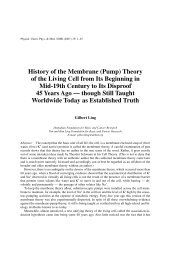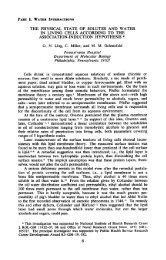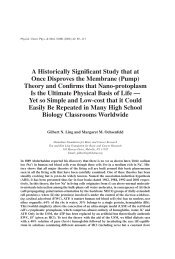Primary Thermosensory Events in Cells - Springer
Primary Thermosensory Events in Cells - Springer
Primary Thermosensory Events in Cells - Springer
Create successful ePaper yourself
Turn your PDF publications into a flip-book with our unique Google optimized e-Paper software.
25 <strong>Primary</strong> <strong>Thermosensory</strong> <strong>Events</strong> <strong>in</strong> <strong>Cells</strong> 459<br />
Fig. 25.1 A hypothetical model of a free energy profile of a globular prote<strong>in</strong>. The threshold<br />
character of the prote<strong>in</strong> reaction means that the rest<strong>in</strong>g states and the active states are different<br />
thermodynamic states of the system, separated by an energy barrier. Often, several prote<strong>in</strong> states<br />
are thermodynamically stable and prevail <strong>in</strong> appropriate conditions. Transitions between different<br />
prote<strong>in</strong> states take place <strong>in</strong> the cell <strong>in</strong> response to external stimuli<br />
The motions <strong>in</strong>volved to get from one state to another are usually much more<br />
complex than the oscillation of atoms and groups about their average positions. In<br />
prote<strong>in</strong>s, because most of the forces that stabilize the native state are non-covalent,<br />
there is enough thermal energy at physiological temperature for weak <strong>in</strong>teractions<br />
to break and reform frequently. Thus a prote<strong>in</strong> molecule is more flexible than a<br />
molecule <strong>in</strong> which only covalent forces dictate the structure.<br />
Recently, it became clear that natively unfolded prote<strong>in</strong>s also play an important<br />
role <strong>in</strong> the cell. Dunker et al. [63] proposed to widen the notion of functional prote<strong>in</strong><br />
types <strong>in</strong> the cell: to the “classical” prote<strong>in</strong>s with well def<strong>in</strong>ed tertiary structure,<br />
they added molten globules and prote<strong>in</strong>s with unfolded conformations. Uversky<br />
[64] has suggested to supplement this list with a fourth, relatively stable prote<strong>in</strong><br />
conformation – the premolten globule, which might be called the boil<strong>in</strong>g globule,<br />
as <strong>in</strong> the coord<strong>in</strong>ates of the unfold<strong>in</strong>g reaction it follows the globule and molten<br />
globule and precedes the completely unfolded conformation. Apparently, all these<br />
prote<strong>in</strong> states are thermodynamically stable, although to different degrees.<br />
Even when the native prote<strong>in</strong> does not undergo a conformational change, it is<br />
still characterized by the occurrence of a large number of local unfold<strong>in</strong>g events that<br />
give rise to many sub-states. Thus, the native state itself needs to be considered as<br />
a statistical ensemble of conformations rather than unique entity. These dist<strong>in</strong>ctions<br />
are very important from the functional po<strong>in</strong>t of view s<strong>in</strong>ce different conformations<br />
are usually characterized by different functional properties.







